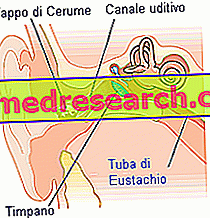Generality
The veins of the arm are the venous vessels of the upper limb, provided, however, that the term "arm" indicates the anatomical tract between the hand and the shoulder.

According to the most classical of anatomical visions, the veins of the arm can be distinguished in two broad categories: superficial arm veins and deep arm veins.
To the category of superficial arm veins belong: the basilic vein, the cephalic vein, the median cubital vein and the axillary vein; the category of deep arm veins, on the other hand, includes: the radial vein, the ulnar vein, the brachial vein and the perforating veins of the arm.
Arm veins can be protagonists of some important conditions, particular pathologies; furthermore, they can be used in the field of vascular surgery, general medicine and cardiac surgery.
Short review of what a vein is
In human anatomy, the list of veins includes any blood vessel responsible for transporting blood from the periphery (where the body's tissues and organs are meant for the periphery) to the heart.
Contrary to what many people think, in the veins NOT only non-oxygenated blood flows (ie oxygen-free); to demonstrate what is just stated is the existence of pulmonary veins, ie the venous vessels designed to carry oxygen-rich blood from the lungs to the heart, so that the latter can then spread it to the periphery.
The veins differ from the arteries from the structural point of view: compared to the second, the former are less extensible and less thick.
What are the Veins of the Arm?
The veins of the arm are the venous vessels of the upper limb, in the sense in which, however, the term "arm" includes the hand and the anatomical tract between the wrist and shoulder .
In other words, according to the more extended (and less appropriate) view of the word "arm", the veins of the arm are the veins that, starting from the final extremity of the upper limb (hand), run through the entire forearm, the elbow and all the anatomo-skeletal section occupied by the humerus ( proper arm ).
Short explanation
In human anatomy, the arm (or proper arm) is the anatomical section between the elbow and the shoulder and made up of a single bone, the humerus.
In common parlance, however, it is possible to assign the broader meaning of "upper limb" to the word "arm".
Anatomy
To simplify the anatomical description of the veins in the arm, the anatomists distinguish the aforementioned vessels in two categories: superficial arm veins and deep arm veins .
Superficial arm veins
The superficial arm veins are: the basilic vein, the cephalic vein, the median cubital vein and the axillary vein .
The adjective "superficial" indicates that these veins of the arm reside in the subcutaneous.
To understand the subsequent descriptions of the veins of the arm ...
- The description of the path of the veins of the arm starts from the periphery, since the direction of flow of the blood within these vascular ducts is from the periphery to the heart .
- If the palm of the hand is facing the observer, the medial side of the upper limb is the portion of the latter closest to the trunk.
- If the palm of the hand is facing the observer, the lateral side of the upper limb is the portion of the latter furthest from the trunk.
VENA BASILICA
Of not negligible diameter, the basilic vein originates on the medial (or ulnar ) side of a complex of blood vessels of the hand, called the dorsal venous network .
Arising from the so-called metacarpal dorsal veins of the hand, the dorsal venous network resides on the superficial fascia of the back of the hand and represents the venous complex in which most of the blood that has previously sprayed the tissues of the hand converges.
From the dorsal venous network, therefore, the basilic vein begins a path of ascent upwards, towards the shoulder, which leads it to position itself, first, on the anteromedial portion of the forearm (on the side of the ulna ) and, then, on the medial portion of the arm proper (internally to the humerus ).
The ulna is, along with the radius, one of the two bones that make up the skeleton of the forearm .
In the situation where the palm of the hand is facing the observer, the ulna lies on the medial side of the upper limb.
The humerus, on the other hand, is the arm bone proper.

In undertaking the aforementioned ascent, the basilic vein obviously passes through the elbow; its passage in this seat is anatomically important, since it is at the level of the anterior elbow that the basilic vein is joined, via the median cubital vein, to the cephalic vein.
The basilic vein ends its course just over half of the proper arm, after having pierced the so - called brachial fascia (at the level of the medial epicondyle of the humerus ), having reached the inferior margin of the large round muscle and having received the contribution of venous blood of the brachial vein.
To mark the conclusion of the basilic vein is its confluence in the axillary vein.
Did you know that ...
The protruding arm veins are associated with a body in excellent shape. It is, in fact, very common to observe them in those who practice sports on a daily basis and lead a healthy and particularly active lifestyle.
VEIN VENETHAL
The cephalic vein represents the vein of the arm opposite to the basilic vein. Compared to the latter, in fact, it creates a lateral (or radial) slope of the dorsal venous network and undertakes a path of ascent towards the shoulder so that it occupies an antero-lateral position on the forearm, first, and a lateral position on the arm properly said then.

As previously stated, at the level of the elbow (upper face), the cephalic vein establishes indirect contact with the basilic vein, through the median cubital vein.
The course of the cephalic vein ends at the armpit level, after passing through a particular anatomical region located between the deltoid and pectoralis major muscles, and called the deltopectoral sulcus .
The confluence in the axillary vein marks the conclusion of the cephalic vein.
Did you know that ...
Among the veins of the arm, the cephalic vein is the one easily visible (especially in normal-weight subjects) on the latero-superior portion of the right arm, in correspondence with the inferior margin of the deltoid muscle.
MEDIAN CUBE STREET
As readers already know from the two previous descriptions, the median cubital vein is the vein of the arm that communicates, in correspondence with the anterior aspect of the elbow, the basilic vein and the cephalic vein.
On the elbow, the median cubital vein occupies a very precise position: it resides in the so-called cubital fossa, above the bicipital aponeurosis, that is, the fibrous band that separates the deep structures of the cubital fossa from the superficial ones.

Did you know that ...
Of the veins of the arm, the median cubital vein is that which becomes very evident, at the time of applying a pressure just above the elbow.
VENA ASCELLARE
Located in the axilla region, the axillary vein is a large venous vessel whose course begins at the inferior margin of the large round muscle and terminates near the lateral margin of the first rib, where it becomes the subclavian vein .
The large round muscle is a shoulder muscle, which arises on the posterior aspect of the scapula and ends on the anterior aspect of the humerus, just below a structure called the neck.

Representing to all effects the continuation of the basilic and brachial arm veins, the axillary vein accommodates, during its journey up to the subclavian vein, several other venous vessels; among these vessels, the aforementioned cephalic vein, the subscapular vein, the circumflex humeral vein, the lateral thoracic vein and the thoraco-acromial vein deserve a mention.
During his entire journey, the axillary vein flanks the homonymous artery, which is the axillary artery .
Continuation of the subclavian artery, the axillary artery is the artery from which the brachial artery originates, that is the deputed arterial vessel, with its numerous branches, to supply the bones and tissues of the upper limb with oxygenated blood.
Deep arm veins
The deep veins of the arm are: the radial vein, the ulnar vein, the brachial vein and the so-called perforating veins of the arm .
The adjective "deep" indicates that these veins of the hound reside in the deeper tissues of the upper limb.
RADIAL VENA
The radial vein is one of the two main venous vessels of the forearm.
Originating in the deep palmular venous arch, this vein of the deep arm passes along the anterolateral side of the wrist-elbow tract, above the radium and parallel to the radial artery.
As already mentioned, the radius is the bone which, together with the ulna, forms the skeleton of the forearm.
In the situation where the palm of the hand is facing the observer, the radium lies on the lateral side of the upper limb.
The radial vein ends its course at the level of the cubital fossa of the elbow; here, joining the ulnar vein, it gives life to the brachial vein.
VENA ULNARE
The ulnar vein is the second of the two main venous vessels of the forearm.
Originating also in the deep palmar venous arch, this vein of the deep arm runs along the antero-medial side of the wrist-elbow tract, above the ulna and parallel to the ulnar artery.
The path of the ulnar vein ends at the level of the cubital fossa of the elbow, where, repeating what was said previously, its union with the radial vein and the beginning of the brachial vein takes place.
Did you know that ...
Both the radial vein and the ulnar vein communicate, by anastomosis, with the arteries that flank, therefore respectively with the radial artery and the ulnar artery.
BRACIENT VEIN
The brachial vein is the main vein of the deep arm of the anatomical tract between the elbow and the shoulder.
Fruit of the union between the radial vein and the ulnar vein at the level of the cubital fossa of the elbow, this vein rises up the right arm beside the brachial artery, up to the lower edge of the large round muscle, the site where it flows into the axillary vein .
In the path that leads to the connection with the axillary vein, the brachial vein has several tributary veins, which "discharge" the blood devoid of oxygen coming from the biceps brachialis and brachial triceps muscles.
VENE PERFORANTI DEL ARM
The perforating veins of the arm are all those deep minor venous vessels which, crossing the deep muscular bands, connect the deep veins of the arms with the superficial veins of the arm.
Function
The veins of the arm constitute the venous network which has the task of draining the deoxygenated blood from the bone tissues and from the soft tissues of the upper limb, and directing it to the heart, for its re-oxygenation.
More specifically, the veins of the arm welcome the blood that gave oxygen to the bones, muscles, skin, etc. of the hand, of the forearm and of the arm proper.
diseases
Although much less frequently than the veins in the lower limb, the veins in the arm can be the subject of thrombophlebitis.
Furthermore, due to a vein in the arm such as the axillary vein, there is the possibility that from a lesion of this venous armpit vessel, in addition to severe hemorrhage, a phenomenon called gas embolism also arises.
Thrombophlebitis: what is it?
Thrombophlebitis is the inflammation of the wall of a vein in the upper or lower limbs, due to the formation, in the same vein victim of the inflammatory process, of an abnormal blood clot (whose specific name is thrombus ).
If it affects the superficial arm veins, thrombophlebitis is an example of superficial thrombophlebitis; if instead it concerns deep arm veins, thrombophlebitis is an example of deep thrombophlebitis or deep vein thrombosis .

Gas embolism
Gas embolism is the dangerous pathological condition that occurs when one or more air bubbles block the flow of blood inside a blood vessel.
The gaseous embolism resulting from a lesion affecting the axillary vein is an example of venous gas embolism.
Did you know that ...
The danger of air embolism is related to the possibility that:
- The air bubble reaches the blood vessels of the brain, causing a stroke;
- The air bubble reaches the coronaries, causing a heart attack;
- The air bubble reaches the pulmonary artery, causing respiratory failure.
Clinical Use
Some veins in the arm are used in the clinical-therapeutic and clinical-diagnostic fields.
The veins of the arm in question are the basilic vein, the cephalic vein and the median cubital vein.
Use in medicine of the basilic vein
The vein of the basilic arm is very suitable for the creation of an arteriovenous fistula, when a vascular access is needed for hemodialysis (hemodialysis is a treatment for chronic renal failure ).

Use in medicine of the cephalic vein
The vein of the cephalic arm is, together with the subclavian vein, one of the two venous vessels within which the cardiac surgeons pass the indispensable leads connecting a pacemaker to the heart.
Use in medicine of the median cubital vein
Being very superficial, the median cubital vein is an excellent candidate for venipuncture, that is, the operation of puncturing a vein for a blood sample or an injection.
In fact, other veins of the arm also lend themselves to venipuncture, but the median cubital vein is absolutely the best.



